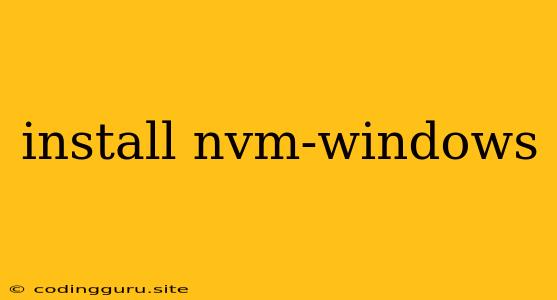What is NVM-Windows?
NVM-Windows, short for Node Version Manager for Windows, is a powerful tool that allows you to easily manage different versions of Node.js on your Windows machine. This is crucial for developers working on multiple projects that might require different Node.js versions, ensuring compatibility and preventing conflicts.
Why use NVM-Windows?
Here's why NVM-Windows is essential for any Node.js developer on Windows:
- Multiple Node.js Versions: You can install and switch between various Node.js versions seamlessly, making it perfect for projects with specific Node.js requirements.
- Global vs. Project-Specific: NVM-Windows allows you to isolate Node.js versions for individual projects, preventing conflicts and ensuring the right version is used.
- Easy Management: Effortlessly switch between different versions, install new versions, and even uninstall older ones with simple commands.
- Consistent Environment: NVM-Windows ensures a consistent development environment by making sure you're using the correct Node.js version for each project.
Installing NVM-Windows
Prerequisites:
Before installing NVM-Windows, make sure you have:
- Windows 7 or later: NVM-Windows requires a recent Windows operating system.
- Git: You'll need Git installed on your system.
Installation Steps:
-
Download the NVM-Windows installer: Download the latest version of the NVM-Windows installer from the official website.
-
Run the installer: Run the downloaded executable file and follow the on-screen prompts. It will install NVM-Windows and configure your system to use it.
-
Verify installation: Open your command prompt or PowerShell and run the following command:
nvm --versionYou should see the installed NVM-Windows version if the installation was successful.
Using NVM-Windows
Listing Available Node.js Versions:
To view the available Node.js versions that can be installed, use:
nvm ls-remote
This command will display a list of all the available Node.js versions.
Installing a Specific Node.js Version:
To install a specific Node.js version, run:
nvm install
Replace <version> with the desired Node.js version number. For example, to install Node.js version 16.14.0, you would use:
nvm install 16.14.0
Switching Node.js Versions:
Once you have installed multiple Node.js versions, you can easily switch between them using:
nvm use
Replace <version> with the version number you want to use.
Setting a Default Node.js Version:
To set a specific Node.js version as the default for all your projects, use:
nvm alias default
Replace <version> with the version you want to set as the default.
Managing Node.js Versions:
NVM-Windows provides several other useful commands for managing Node.js versions:
nvm uninstall <version>: Uninstall a specific Node.js version.nvm list: List all installed Node.js versions.nvm current: Display the currently active Node.js version.nvm node-path: Get the path to the currently active Node.js executable.
Troubleshooting
If you encounter issues with NVM-Windows, try these troubleshooting steps:
- Restart your computer: Sometimes restarting your computer after installing NVM-Windows can resolve issues.
- Check your environment variables: Make sure your environment variables are correctly configured after installing NVM-Windows.
- Update NVM-Windows: If you're experiencing issues, update NVM-Windows to the latest version to see if it resolves the problem.
Conclusion
NVM-Windows is an essential tool for any Node.js developer on Windows. It simplifies the management of multiple Node.js versions, ensuring a consistent development environment for your projects. By installing and using NVM-Windows, you gain a powerful and efficient way to navigate the complexities of different Node.js versions.
